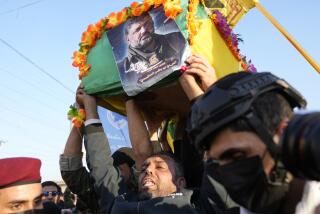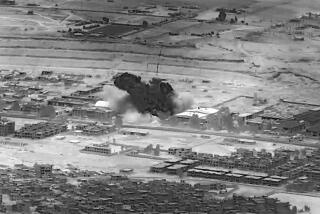Iraq violence is up since troop boost
- Share via
WASHINGTON — Violence in Iraq rose slightly in the three months ended in May because of increased attacks in cities and provinces that had been relatively peaceful before the Bush administration’s troop buildup, the Pentagon reported Wednesday.
The intense focus on Baghdad and western Iraq by newly arriving U.S. troops pushed insurgent groups into other regions, causing a rise in violence in northern and eastern provinces such as Diyala and Nineveh, the Pentagon said in a quarterly report to Congress on Iraqi security.
The U.S. military repeatedly has touted decreases in sectarian and insurgent killings in Baghdad and Al Anbar province, which have been the focus of the so-called surge that has added 28,500 combat and support troops. U.S. officials have acknowledged problems in Diyala, and the report for the first time documents that rising violence there and in other outlying provinces has largely offset gains in Iraq’s center. Overall, the average of more than 1,000 attacks each week represented a 2% increase from the preceding three months.
The report is the first in a series of Pentagon evaluations to cover a period that encompasses the troop buildup. The report contains frequent caveats, noting that additional forces were still arriving during the February-to-May period evaluated, and it repeatedly asserts that it is too early to draw firm conclusions about the buildup.
But the rise in violence elsewhere reveals an early trend that could further complicate the Bush administration’s goals in Iraq. U.S. military plans do not include deploying additional troops in outlying provinces, despite calls by some commanders for more forces to deal with the rise in insurgent attacks in those places.
According to the report, Shiite Muslim fighters affiliated with radical cleric Muqtada Sadr have been moving south over the last three months, contributing to a “significant increase in attacks” on coalition forces in the city of Basra and inflaming inter-Shiite factionalism in the region.
The report documents the movement of significant numbers of Sunni insurgents linked to Al Qaeda in Iraq, confirming anecdotal reports of Al Qaeda fighters leaving Al Anbar and setting up new bases in Diyala province, where U.S. military officials have requested more troops.
But the report also shows that the violence has moved beyond the well-publicized flare-ups in Diyala. In Mosul, the country’s third-largest city, Iraqi forces have been able to maintain security with minimal U.S. assistance, but the report says insurgent and terrorist groups have increased the frequency and intensity of their attacks against police.
The same is true in the northern city of Tall Afar, once touted by the White House as a case study in how its new counterinsurgency plan could be effective. There, Sunni extremists linked to Al Qaeda in Iraq have attempted to reignite sectarian conflicts through a series of “high-profile attacks against civilians,” the study says.
Similar problems are reported in the ethnically mixed city of Kirkuk and the Sunni stronghold of Baqubah.
“Outside Baghdad and Anbar, reductions in coalition force presence and reliance upon local Iraqi security forces have resulted in a tenuous security situation,” the report says. “Sectarian violence and insurgent attacks still involve a very small portion of the population, but public perceptions of violence have adversely affected reconciliation and contribute to population migration.”
The report holds out hope that the recent move by Sunni sheiks in Al Anbar province to work with the U.S. military to fight Al Qaeda insurgents also could be achieved in Diyala, where discussions are underway with residents on how to counter Al Qaeda-linked attacks.
The report highlights the striking decrease in the number of civilian deaths in Baghdad and Al Anbar provinces through May, but notes that the decline in sectarian killings may be only temporary. In fact, U.S. military officials have noted a rise in such slayings, but they occurred too recently to be covered by the report.
The report reflects the growing frustration within the Pentagon over the continuing failure of the Iraqi government to use the troop increase as an opportunity to enact legislative reforms aimed at reconciliation.
Although the report holds out hope that a new law divvying oil revenue could soon be passed, it all but concedes that no other major piece of legislation will be approved before September, when the administration is expected to unveil its formal evaluation of the surge.
The study says reform of Iraq’s draconian de-Baathification laws, which U.S. officials see as key to bringing disaffected Sunnis back into the political process, appears to be stalled.
Similarly, legislation setting a date for provincial elections -- another move seen as central to empowering Sunnis -- is expected to be delayed until fall, the report says.
“Reconciliation remains a serious unfulfilled objective,” the report says.
The report is comparatively upbeat regarding the performance of the Iraqi army in the new security push, finding that though initial battalions deployed to Baghdad were short troops, battalions arriving later had more soldiers.
The Iraqi government occasionally has intervened politically in the army’s operations, however. The report says some government officials have bypassed the chain of command to order specific army operations, some of which were designed to pursue sectarian goals.
Lt. Gen. Martin Dempsey, the U.S. Army commander who until last month headed the training of Iraqi units, said he expected the readiness of deploying Iraqi units to decline as the Baghdad security plan unfolded, because the most capable battalions were the first to be sent.
“We could leave those units in Baghdad for a much longer period of time, thereby reducing the turbulence and probably making the tactical fight a little cleaner,” Dempsey said Wednesday at a Pentagon news conference.
“We learn enormous lessons when we move them around. We learn about what their leaders are capable of, we learn about the degree of reliability and loyalty.”
--
More to Read
Sign up for Essential California
The most important California stories and recommendations in your inbox every morning.
You may occasionally receive promotional content from the Los Angeles Times.










